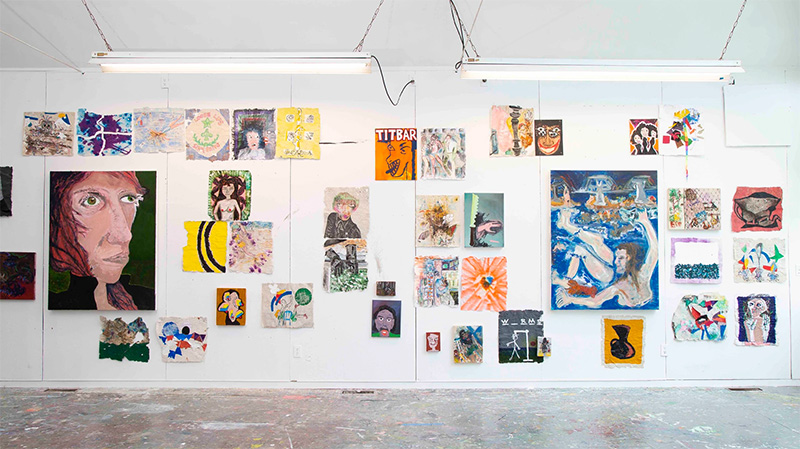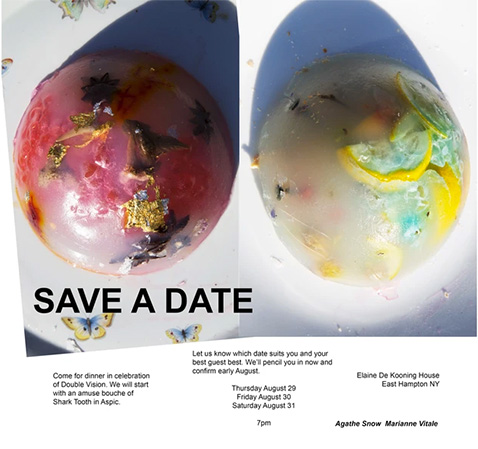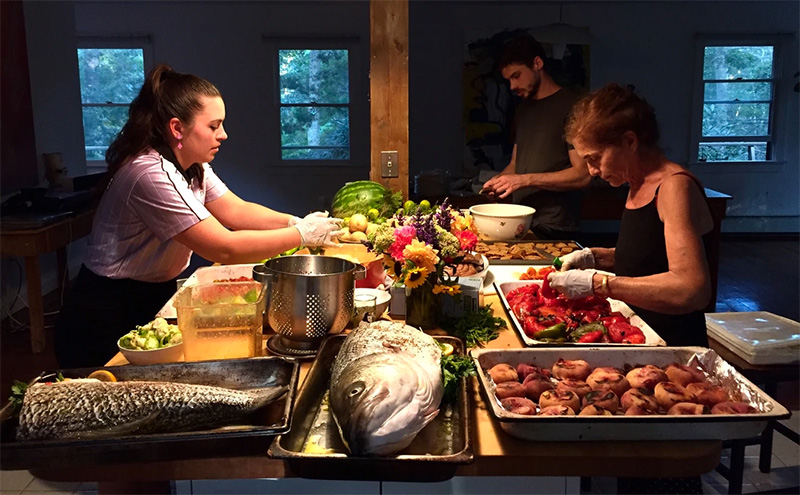
- Source: GARAGE
- Author: EILEEN CARTTER
- Date: SEPTEMBER 22, 2019
- Format: DIGITAL
Double Vision (and Other Senses) with Agathe Snow and Marianne Vitale
At the Elaine de Kooning House, the artists played with sight and taste through collaborative portraiture, and fish stew.

Double Vision, installation view at the Elaine de Kooning House, Courtesy of Agathe Snow and Marianne Vitale
For artists Agathe Snow and Marianne Vitale, food is inevitable. The pair met for the first time around 15 years ago at a samosa shop on Houston (but not, Vitale says, the one you’re thinking of).
Around the time of the Democratic presidential primaries in 2008, the duo took a road trip from New York’s Chinatown, where Snow lived at the time, to Los Angeles’s Chinatown, where she had a show. Accordingly, they drove across the country dining only at Chinese-American restaurants, where they encountered, Vitale said, “the different hues of egg drop soup” along the way. They approached that trip like a project, method and all: they’d get the same thing each place (brown rice, steamed vegetables with black bean sauce, the aforementioned soup), an homage to the exact takeout order their friend always had delivered to their Rivington Street studio years before.

The invitation for the duo’s series of dinners at the Elaine de Kooning House. Courtesy of Agathe Snow and Marianne Vitale
This first chapter, they said, was for Elaine. While they’re sculptors at heart—much of the work they’ve created together and separately has been ephemeral and experiential, though Snow said, lately she feels “everything has to last all of a sudden”—they were excited to honor “the house of painting,” which Elaine de Kooning purchased in 1975 after reconciling with her husband, Willem.
The pair had fun with the unfamiliar medium: for canvas, they crafted their own paper and felt made of, among other things, coffee grounds and rotten lettuce (as far as surfaces go, they said it sucked to paint on). They both came up with lists of 19 phrases (“women’s movement,” “wilderness,” “egg salad,” “jumper cable”) and painted a piece per phrase. They each painted a self-portrait and a portrait of one another. They made sculptures, too, including a functioning “Tit Bar” made of cedar blocks, and an installation utilizing car bumpers left at the house by its owner after Elaine, John Chamberlain.
Snow said, lately she feels “everything has to last all of a sudden.”
“The house was really Elaine for us,” Snow said, though “Chamberlain nudged himself in there” — “with his big, hard fender,” Vitale added.
Working at the de Kooning house was also an opportunity to fuse its artistic legacy with the innate domesticity of being in a home, which included cooking at its truly impressive industrial oven. “You get handed this beautiful house with a lot of history—it’s not just a studio,” Vitale said. “It was a house—you showered, you ate… We lived there.”

Dinner preparation on Labor Day weekend, featuring a humongous striped bass from Block Island. Courtesy of Katherine McMahon
To showcase their works, they hosted a series of dinner parties over Labor Day weekend, which featured heirloom tomato tarts, homemade bread with anchovy butter, cheeses from Martha’s Vineyard, babaganoush, and candied orange slices dipped in chocolate. At the Tit Bar, they served Casa Dragones tequila, wines from the North Fork, and smoked oysters. The menus were collaborative efforts and the meals often played in tandem, in true double-vision fashion. For one dinner, Snow’s mother, Martine Abitol, prepared a 30-pound striped bass caught on nearby Block Island; for the next, Snow used its bones to make stock for a warm-spiced fish stew. The stew was served family-style, on a table decorated with rainbow saltwater taffy and half-spheres of oyster shells, cinnamon sticks, and feathers suspended in agar-agar.
“We’ve always made food as part of our art together,” they said, which was a natural progression of their respective histories: Snow grew up in her parents’ restaurant in Corsica and later, her mother’s restaurant, La Poeme, on Prince and Elizabeth Streets, while Vitale once worked at famed bistro and artist hangout Lucien. For the “Double Vision” meals, Snow loved that “each food was so particularly sentimental,” whether it was grown in a garden on the de Kooning property (only to become “bespoke edibles for the fucking deer,” Vitale contended), carried across multiple ferries, or tenderly donated by friends.
At the de Kooning house, artists-in-residence traditionally leave a piece behind to live on the grounds, and so Snow and Vitale’s vision had to expand and multiply to include the eyes and works accompanying them in the space, splintering their notion of double vision into a kaleidoscope of reference points. “Snow and Vitale demonstrate that life can be a gas if we desist from worshiping false foundations,” their press release delightfully reads, “so why not rub up against ghosts for inspiration. After successful masturbation, your eyes will adjust.”
While pieces from their de Kooning residency travel to art shows in Bridgehampton, Chicago, and Miami via New Discretions, Snow and Vitale hope to enact the next chapters of their series elsewhere on the Atlantic coast before heading west, with an eventual conclusion back in New York. Expect there to be food, served in their signature buoyant, unprecious style. Entertaining, it seems, comes relatively easily.
“The agony is in the art-making,” Vitale said. “But we’re not not going to have people over.”

